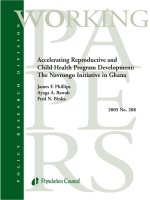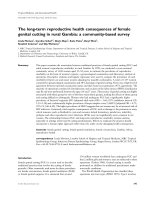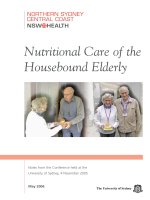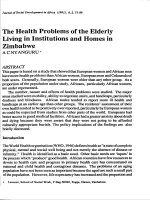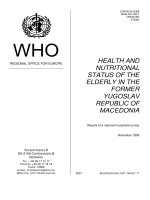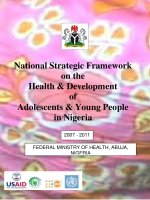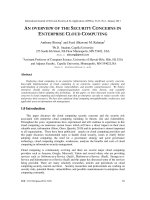Loneliness, Depression and Health Status of the Institutionalized Elderly in Korea and Japan pptx
Bạn đang xem bản rút gọn của tài liệu. Xem và tải ngay bản đầy đủ của tài liệu tại đây (243.42 KB, 8 trang )
63
Asian Nursing Research ❖ June 2009 ❖ Vol 3 ❖ No 2
ORIGINAL ARTICLE
Loneliness, Depression and Health Status
of the Institutionalized Elderly in
Korea and Japan
Oksoo Kim
1
*, RN, PhD, Young-Soon Byeon
2
, RN, PhD, Jung-Hee Kim
3
, RN, PhD,
Emiko Endo
4
, RN, PhD, Makoto Akahoshi
5
, RN, PhD, Hiromi Ogasawara
6
, RN, MS
1
Professor, Division of Nursing Science, Ewha Womans University, Seoul, Korea
2
Professor, Division of Nursing Science, Ewha Womans University, Seoul, Korea
3
Full-time Lecturer, Department of Nursing, Woosuk University,
Wanju-gun, Korea
4
Professor, Musashino University, School of Nursing, Tokyo, Japan
5
Professor, Miyazaki Prefectural Nursing University, Miyazaki, Japan
6
Associate Professor, Miyazaki Prefectural Nursing University, Miyazaki, Japan
Purpose The purpose of the study was to describe loneliness, depression, and health status in Korean
and Japanese institutionalized elderly and explore differences between the countries. Also this study deter-
mined predictors of depression in each group.
Methods Elderly subjects, aged 65–98 (n = 184), were recruited from private nursing homes in Korea
and Japan. Subjects were interviewed on health status, loneliness, and depression.
Results Korean subjects had higher loneliness scores than Japanese. More Korean elderly had depres-
sive symptoms than Japanese elderly. The mean GDS score of Korean elderly was 8.07 and that of Japan-
ese elderly was 5.21. Korean elderly had less physical function, and perceived their general health to be
poor. Loneliness and perception of general health were significant predictors of depression in Korean and
Japanese subjects.
Conclusion It is necessary to assess the levels of loneliness and depression of institutionalized Korean
elderly and pursue an intervention to reduce these problems. [Asian Nursing Research 2009;3(2):63–70]
Key Words aged, depression, health status, loneliness
*Correspondence to: Oksoo Kim, RN, PhD, Professor, Division of Nursing Science, Ewha Womans
University, 11-1 Daehyun-dong, Seodaemun-gu, 120750 Seoul, Korea.
E-mail:
INTRODUCTION
In recent times, Korea has become an increasingly
aging society. The elderly aged 65 and over consti-
tuted about 9.7% of the Korean population in 2005
and numbers are expected to reach more than 24.1%
in 2030 (Korea National Statistical Office, 2005). In
Japan, people over 65 years of age constituted 20.0%
of the population in 2005, with an anticipated
31.8% in 2030 (National Social Security, 2006).
Received: January 28, 2009 Revised: February 4, 2009 Accepted: April 30, 2009
With the growing elderly population, an interest in
physical and psychosocial health of the elderly has
concomitantly increased.
Depression in the elderly is a widespread prob-
lem that is often not diagnosed and frequently under
treated in Korea (Yang & Rim, 2006). The levels of
depression of institutionalized Korean elderly are
reported to be higher than those of community resid-
ing Korean elderly (Oh & Choi, 2005). Previous
findings suggest that depression can be associated
with an increased risk of incidence of dementia and
ideation of suicide in the elderly (Devanand et al.,
1996; Vannoy et al., 2007). Therefore, healthcare
providers need to recognize the factors associated
with depression in the institutionalized elderly so
they can be prevented.
Loneliness and worsening health have been
shown to be risk factors for depressive symptoms.
Cacioppo, Hughes, Waite, Hawkley, and Thisted
(2006) reported that higher levels of loneliness were
associated with more depressive symptoms in older
adults.
In the process of aging, elderly people experience
decreasing physical function and worsened general
health (Crews & Zavotka, 2006; Martin, Bishop,
Poon, & Johnson, 2006). It has been found that when
considering psychosocial status such depression has
a relationship with health (Jeon, Kim, & Kim, 2005).
Residents in nursing homes have many physical and
psychosocial needs, as elderly people who move into
nursing homes experience a rapid change in their
psychophysical balance (Degenholtz, Kane, Kane,
Bershadsky, & Kling, 2005; Scocco, Rapattoni, &
Fantoni, 2006).
In Korea and Japan, the oldest son or daughter of
a family traditionally takes care of their elderly par-
ents. Today, this tradition is not being practiced to
the same extent.The nuclear family is now the norm
in Korea due to the rapid modernization of society.
Many elderly people do not want to be a burden to
their adult children. Therefore, the number of Korean
elderly who want to enter nursing homes may in-
crease in the future (Kim et al., 2005). The current
knowledge is predominantly based on information
from studies among community-dwelling elderly.
Few studies have examined loneliness and depres-
sion among nursing home clients.
Both countries are the most rapidly aging soci-
eties in Asia, and they share similar Confucian cul-
tural traditions. Japan became an aging society earlier
than did Korea, and the perspective on institution-
alization of the elderly is more positive in Japan. Per-
spectives on nursing home institutionalization may
influence psychological status in elderly people.
The purpose of this study was to investigate the
differences in loneliness, depression, and health sta-
tus in institutionalized Korean and Japanese elderly.
In addition, the predictors of depression were exam-
ined in both groups.
METHODS
Participants and procedures
This study used a convenience sample of 184 insti-
tutionalized elderly. Eighty-one participants were
Korean and 103 were Japanese. All were at least 65
years of age. Participants were recruited from two pri-
vate nursing homes in Seoul, Korea and eight private
nursing homes in Miyazaki, Japan. Directors’ approval
were obtained from the institutions. Elderly people
who could communicate with interviewers were in-
cluded in this study. The participants were assured
of anonymity and confidentiality. All participants
gave written consent to participate in the study.
All information was collected through face-to-face
interviews using the questionnaires in Korean and
Japanese by the investigators.
Measures
Loneliness was measured by the Revised UCLA
Loneliness Scale (RULS; Russell, Peplau, & Cutrona,
1980). The RULS is a 20-item, 4-point scale ranging
from never (1) to often (4), with a total score of
20–80. The RULS includes 10 items that reflect
satisfaction with social relationships and 10 that
reflect dissatisfaction (Russell et al.). The scores of
items that were positively worded were reversed
before summing. Reported Cronbach’s alpha was .94
(Russell et al.). In a validity test, loneliness scores
O. Kim et al.
64
Asian Nursing Research ❖ June 2009 ❖ Vol 3 ❖ No 2
65
Depression in the Elderly
Asian Nursing Research ❖ June 2009 ❖ Vol 3 ❖ No 2
were significantly correlated with scores on the
Beck Depression Inventory (r = 5.62). Construct
validity of the Korean version of the RULS was
established and the reported Cronbach’s alpha was
.93 (Kim, 1997). In this study, Cronbach’s alphas
were .91 and .86 in the Korean and Japanese sam-
ples, respectively.
Depression of the subjects was assessed by the
Geriatric Depression Scale-15. The Geriatric Depres-
sion Scale-15 (GDS-15) is a short, 15-item instru-
ment specifically designed to assess depression in
geriatric populations. Its items require a yes/no re-
sponse. The Geriatric Depression Scale was first
introduced by Yesavage (1992), and the short form
(GDS-15) was developed by Sheik and Yesavage
(1986). A GDS score of 6 or higher, up to 15 is indica-
tive
of “probable” depression. Concurrent and dis-
criminant validity of the Korean version of the GDS
was established and the reported Cronbach’s alpha
was .90 (Bae & Cho, 2004). Sensitivity and speci-
ficity
of the Japanese version of GDS were reported
(Schreiner, Hayakawa, Morimoto, & Kakuma, 2003).
The reported Cronbach’s alpha was .85 in the
Japanese GDS (Ide, 2000). In this study, Cronbach’s
alphas were .81 and .80 in the Korean and Japanese
sample, respectively.
Physical functioning and general health perception
was measured to evaluate health status using SF-36
Version 1 (Stewart, Hays, & Ware, 1988).The 36-item
Medical Outcome Short Form Health Survey (SF-36)
questionnaire was designed as a generic indicator of
health status for the general population, which allows
it to be self-administered. Physical Functioning is as-
sessed using a 10-item, 3-point scale and the Gen-
eral Health Perception is assessed using a 4-item,
5-point scale. For each scale, item scores are summed
and transformed on a scale from 0 (worst possible
health status) to 100 (best possible health status).
Discriminant validity of the Korean and Japanese
versions of SF-36 was established and reported
Cronbach’s alphas were .93–.94 and .84–.86 in the
Korean and Japanese version, respectively (Fukuhara,
Bito, Green, Hsiao, & Kurokawa, 1998; Han, Lee,
Iwaya, Kataoka, & Kohzuki, 2004). Cronbach’s alphas
for Physical function were .93 and .92, and .66 and
.84 for General Health Perception in the Korean
and Japanese samples, respectively.
Statistical analysis
Statistical tests (two-tailed, p < .05) were carried out
using SPSS (Version 15.0). Chi-square test and t-test
were performed to show comparisons of Korean and
Japanese elderly in demographic variables which in-
cluded age, gender, education, marital status, the
number of children and current illnesses. ANCOVA
was conducted to assess a difference between Korean
and Japanese elderly in study variables (loneliness,
depression and health status). Age, gender, educa-
tion and current illness were controlled as covari-
ates. Simultaneous multiple regression analysis was
used to test loneliness, physical function and general
health perception had significant effects on depres-
sion in each group.
RESULTS
General characteristics
Table 1 shows a comparison between the background
variables in Korean and Japanese elderly (age, gen-
der, education, having a spouse, the number of chil-
dren, and current illness). A significant difference
was found between the average age of Korean el-
derly compared with that of the Japanese (t = –3.07,
p = .00). The majority (93.8%) of Korean older
adults institutionalized in Korean nursing homes
were female, while 74.8% were female in Japanese
nursing homes. Concerning educational level, the
majority of the Korean elderly (90.0%) graduated
from elementary school or lower, while the Japanese
elderly who graduated from high school or higher
constituted the greatest percentage in this variable.
More Korean subjects reported having current ill-
ness (96.3%;
χ
2
= 6.85, p = .01) compared with
Japanese (84.5%). No significant group differences
were found for having a spouse and
children.
Level of loneliness, depression, and health status
There was a significant difference in the level of lone-
liness between Korean and Japanese participants
O. Kim et al.
66
Asian Nursing Research ❖ June 2009 ❖ Vol 3 ❖ No 2
(Table 2). Korean subjects had higher loneliness
scores than Japanese (t = 24.53, p = .00).
In terms of loneliness, moderate loneliness was
the most prevalent in the loneliness group of
Korean elderly, while low loneliness was most com-
mon among the Japanese elderly.
In depression, the mean GDS score of Korean el-
derly was 8.07, while that of Japanese elderly was
5.21. However, there was no significant mean differ-
ence in the level of depression between the Korean
and Japanese (t = 2.25, p = .14). Notably, 66.7% of
the Korean elderly scored ≥ 6 on the GDS, which in-
dicates the need for further evaluation. This preva-
lence of depressive symptoms was higher than the
rate of 41.7% among the Japanese elderly (
χ
2
= 10.80,
p = .00). Fifty eight percent of the Japanese elderly
were in the not depressed group.
The Korean elderly had less physical function
(t = 6.66, p = .01) and poor general health percep-
tion (t = 5.69, p = .02).
Multiple regression analysis
Simultaneous multiple regression analysis was used
to test which variables had significant effect on depres-
sion in each group. In these models, loneliness, phys-
ical functioning, and general health perception were
entered as independent variables. Table 3 shows
that loneliness and general health perception were
significant predictors of depression for the Korean
and Japanese subjects. Regression analysis indicated
that 55% of the variance in depression scores was
explained by these variables in the Korean elderly.
DISCUSSION
The purpose of this study was to identify the pre-
dictors of depression in Korean and Japanese elderly
subjects dwelling in nursing homes by comparing
each group’s depression, loneliness, physical function,
and health perception.
Table 1
Differences in Background Characteristics in the Korean and Japanese Groups
Korean (n = 81) Japanese (n = 103)
n (%) n (%)
t or χ
2
p
Age (M ± SD) 79.47 ± 6.28 82.57 ± 7.21 −3.07 .00
Gender 11.77 .00
Male 5 (6.2) 26 (25.2)
Female 76 (93.8) 77 (74.8)
Education 73.87 .00
Elementary school or less 72 (90.0) 27 (26.2)
Middle school 4 (5.0) 31 (30.1)
High school 4 (5.0) 45 (43.7)
Having a spouse 1.05 .27
Yes 15 (19.2) 14 (13.6)
No 66 (80.8) 89 (86.4)
Number of children 4.21 .24
None 21 (25.9) 20 (19.4)
One 11 (13.6) 19 (18.4)
Two 12 (14.8) 25 (24.3)
Three or more 37 (45.7) 39 (37.9)
Current illness 6.85 .01
Yes 78 (96.3) 87 (84.5)
No 3 (3.7) 16 (15.5)
67
Depression in the Elderly
Asian Nursing Research ❖ June 2009 ❖ Vol 3 ❖ No 2
In this study, the level of loneliness in the Korean
elderly was higher than that of the Japanese elderly.
Furthermore, the level of loneliness that Korean
institutionalized elderly experienced was higher
than that of the Korean community-dwelling el-
derly (Kim, 2006). This may be because Korean insti-
tutionalized elderly do not have as many friendly
relationships, compared with community-dwelling
elderly, due to limitations in their social activities
(Sung, 2006). One reason why the level of loneli-
ness of the Korean elderly is higher than that of the
Japanese is that Koreans view nursing homes very
negatively. However, in Japan many view living in
nursing homes as positive and may be seen as better
than living in their own homes (Tsugaruya, 2004).
When classifying the level of depression, 66.7%
of Korean elderly and 41.7% of Japanese elderly
were depressed in this study. Jones, Marcantonio,
and Rabinowitz (2003) reported that 20.3% of
United States elderly dwelling in nursing homes
were depressed, and Sherina, Rampal, Hanim, and
Thong (2006) reported that 54% of the institution-
alized elderly in Malaysia were depressed. Mean-
while, the level of depression of the Korean elderly
is higher than that observed in the United States
and Malaysia. In general, Koreans tend to consider
living in nursing homes very negatively. A study by
Kim et al. (2005) revealed that 62% of adult chil-
dren did not intend to send their elderly parents to
nursing homes. The reason given was that they
Table 2
Differences in Loneliness, Depression, Physical Function and General Health Perception in the Korean and
Japanese Groups
Korean (n = 81) Japanese (n = 103)
M ± SD or n (%) M ± SD or n (%)
t or χ
2
p
Loneliness 48.79 ± 9.39 36.35 ± 10.58 24.53 .00
Low 4 (6.1) 52 (50.5) .00
Moderate 34 (51.5) 38 (36.9)
Moderately high 24 (36.4) 11 (10.7)
High 4 (6.1) 2 (1.9)
Depression 8.07 ± 3.84 5.21 ± 3.52 2.25 .14
GDS score < 6 25 (33.3) 60 (58.3) 10.80 .00
GDS score ≥ 6 50 (66.7) 43 (41.7)
Physical function 55.22 ± 16.65 69.75 ± 20.45 6.66 .01
General health perception 53.57 ± 15.15 68.98 ± 15.15 5.69 .02
Note. Because the comparison of loneliness group was performed by Fisher’s exact test, χ
2
was not presented.
Table 3
Multiple Regressions Predicting Depression in the Korean and Japanese Groups
Predictors
Korean Japanese
b tpFR
2
b tpFR
2
Loneliness .61 5.83 .00 23.17 .55 .36 4.02 .00 13.33 .29
Physical function −.02 −.14 .89 −.14 −1.35 .18
General health perception −.22 −2.03 .05 −.27 −.21 .05
believed that adult children should support their
elderly parents.
The Korean elderly were found to have worse
physical function and health status than the Japanese
elderly. This corresponds to the results of a study
that compared Korean community-dwelling elderly
with Japanese community-dwelling elderly (Choi,
Chae, Kim, & Jeon, 2006). This study found that
the perceived health status of Korean elderly was
lower than Japanese elderly. In Korea, when the el-
derly are healthy or economically stable, they tend
not to dwell in nursing homes (Choi, 2002).
Depression was influenced by loneliness and
general health status in Korean and Japanese elderly.
This corresponds to the study results of Cacioppo
et al., (2006) and Tiikkainen and Heillinen (2005).
These studies examined United States middle-aged
and elderly populations and reported that as the level
of loneliness increased, both populations became
more depressed. In a study by Rauch, Morales,
Zubritsky, Knott and Oslin (2006) that targeted the
Japanese elderly, it was revealed that the elderly
who perceived themselves not to be in good health
were more depressed. According to the results of a
study by Lee and Kim (2005) concerning Korean
low-income elderly, health status affected depres-
sion levels. The results of these two studies men-
tioned above indicate that poor health affects
depression levels.
Aging has occurred in Japanese society earlier
than in Korean society. Overall, the view regarding
institutionalized elderly is more open and positive
in the Japanese society. Hence, perceptions concern-
ing institutionalized elderly are more positive in
Japan. In Korea, when adult children cannot look
after their elderly parents in their homes or when
the elderly do not have enough money to support
themselves, nursing homes are frequently used.
Accordingly, Koreans are not likely to encourage their
elderly parents to dwell in nursing homes because
of Korean traditional filial piety. However, it is likely
that the number of elderly dwelling in institutions
such as nursing homes will increase because the
number of elderly people in Korea is rapidly increas-
ing. Therefore, it is necessary to assess the levels of
loneliness and depression of institutionalized elderly
and pursue an intervention to reduce these problems.
In this study, the institutionalized duration was not
considered as a factor affecting loneliness, depres-
sion, and health status. In future studies, institution-
alized duration may be considered as an influencing
factor.
In conclusion, elderly Koreans experience more
loneliness than elderly Japanese. More Korean eld-
erly had depressive symptoms than their Japanese
counterparts. Additionally, physical function and
health perception of elderly Koreans was found to
be lower than the elderly Japanese in this study. To
mediate depression in the elderly, health care
providers need to assess the level of loneliness as a
possible predictor of depression in the institutional-
ized elderly.
REFERENCES
Bae, J. N., & Cho, M. J. (2004). Development the Korean
version of the Geriatric Depression Scale and its short
form among elderly psychiatric patients. Journal of
Psychosomatic Research, 57, 297–305.
Cacioppo, J. T., Hughes, M. E., Waite, L. J., Hawkley,
L. C., & Thisted, R. A. (2006). Loneliness as a specific
risk factor for depressive symptoms: Cross-sectional
and longitudinal analyses. Psychology & Aging, 21,
140–151.
Choi, M. A., Chae, T. R., Kim, J. I., & Jeon, M. Y. (2006).
Comparison of health status, health-related life
habits, activities of daily living and bio-physical index
between Korean and Japanese elderly. Journal of
Korean Academy of Adult Nursing, 18, 612–621.
Choi, S. H. (2002). Assessing and comparing of attitude
toward institution living and parent-child relationship
between the Korean elderly and the Japanese elderly
in institutions. Journal of Korea Gerontological Society,
22, 163–182.
Crews, D. E., & Zavotka, S. (2006). Aging, disability, and
frailty: Implications for universal design. Journal of
Physiological Anthropology, 25, 113–118.
Degenholtz, H. B., Kane, R. A., Kane, R. L., Bershadsky,
B., & Kling, K. C. (2005). Predicting nursing facility
residents’ quality of life using external indicators.
Health Service Research, 41, 335–357.
O. Kim et al.
68
Asian Nursing Research ❖ June 2009 ❖ Vol 3 ❖ No 2
69
Depression in the Elderly
Asian Nursing Research ❖ June 2009 ❖ Vol 3 ❖ No 2
Devanand, D. P., Sano, M., Tang, M. X., Taylor, S.,
Gurland, B. J., Wilder, D., et al. (1996). Depressed
mood and the incidence of Alzheimer’s disease in the
elderly living in the community. Archives of General
Psychiatry, 53, 175–182.
Fukuhara, S., Bito, S., Green, J., Hsiao, A., & Kurokawa, K.
(1998). Translation, adaptation, and validation of the
SF-36 health survey for use in Japan. Journal of Clini-
cal Epidemiology, 51, 1037–1044.
Han, C. W., Lee, E. J., Iwaya, T., Kataoka, H., & Kohzuki,
M. (2004). Development of the Korean version of
short-form 36-item health survey: Health related
QOL of healthy elderly people and elderly patients in
Korea. The Tohoku Journal of Experimental Medicine,
203, 189–194.
Ide, S. (2000). Influences of cognitive status, depression
and health on the use of memory strategies among
residents of Japanese geriatric nursing facilities. Nurs-
ing and Health Sciences, 2, 143–151.
Jeon, E. Y., Kim, S. Y., & Kim, K. B. (2005). Analysis of
depression and health status in Korean-American
Elderly. Journal of Korean Gerontological Nursing, 7,
157–165.
Jones, R. N., Marcantonio, E. R., & Rabinowitz, T. (2003).
Prevalence and correlated of recognized depression in
U.S. Nursing Homes. Journal of the American Geri-
atrics Society, 51, 1404–1409.
Korea National Statistical Office (2005). Increasing trend
of elderly population. Retrieved September 20, 2008,
from
Kim, J. H. (2006). A study of the relationships between lone-
liness and leisure activities of elderly people. Unpublished
master’s thesis, Ewha Womans University, Seoul, Korea.
Kim, O. S. (1997). Korean version of the Revised UCLA
Loneliness Scale: Reliability and validity test. Journal
of Korean Academy of Nursing, 27, 871–879.
Kim, O. S., Kim, S. S., Kim, K. O., Kim, Y.A., Kim, H. S., &
Park, J. S. (2005). The needs about paying nursing
homes for elderly parents. Journal of Korean Gerontol-
ogy Nursing, 7, 20–27.
Lee, I. S., & Kim, S. W. (2005). A study on factors influ-
encing depression of Medicaid recipients: Focus on
social support. Journal of Welfare for the Aged, 29,
285–308.
Martin, P., Bishop, A., Poon, L., & Johnson, M. A. (2006).
Influence of personality and health behaviors on fatigue
in late and very late life. Journals of Gerontology: Social
Science, 61, 161–166.
National Social Security (2006). Population Research
Institute. Retrieved October 22, 2008, from http://
www.ipss.go.jp.
Oh, M. N., & Choi, W. S. (2005). A study on self-esteem,
death anxiety and depression of the elderly in home
and facilities. Journal of the Korean Home Economics
Association, 43, 105–118.
Rauch, S. A., Morales, K. H., Zubritsky, C., Knott, K., &
Oslin, D. (2006). Posttraumatic stress, depression, and
health among older adults in primary care. American
Journal of Geriatric Psychiatry, 14, 316–324.
Russell, D., Peplau, L. A., & Cutrona, C. E. (1980). The
Revised UCLA Loneliness Scale: Concurrent and dis-
criminant validity evidence. Journal of Personal and
Social Psychology, 13, 6–12.
Scocco, P., Rapattoni, M., & Fantoni, G. (2006). Nursing
home institutionalization: A source of eustress or dis-
tress for the elderly? International Journal of Geriatric
Psychiatry, 21, 281–287.
Schreiner, A. S., Hayakawa, H., Morimoto, T., & Kakuma, T.
(2003). Screening for late life depression: Cut-off
scores for the geriatric depression scale and the Cor-
nell scale for depression in dementia among Japanese
subjects. International Journal of Geriatric Psychiatry,
18, 498–505.
Sheik, J. A., & Yesavage, J. A. (1986). Geriatric Depres-
sion Scale (GDS): recent evidence and develop-
ment of a shorter version. Clinical Gerontologist, 5,
165–173.
Sherina, M. S., Rampal, L., Hanim, M. A., & Thong, P. L.
(2006). The prevalence of depression among elderly
warded in a tertiary care center in Wilayah Perseku-
tuan. Medical Journal of Malaysia, 61, 15–21.
Stewart, A. L., Hays, R. D., & Ware, J. E. (1988). The
MOS short-form general health survey. Reliability
and validity in a patient population. Medical Care, 26,
724–735.
Sung, M. O. (2006). A comparative study on privacy
desire and desire satisfaction of the elderly between
community resident and institutional settings-Based
on the sociodemographic factors. Journal of Welfare for
the Aged, 31, 101–117.
Tiikkainen, P., & Heillinen, R. L. (2005). Association
between loneliness, depressive symptoms and per-
ceived togetherness in older people. Aging & Mental
Health, 9, 526–534.
Tsugaruya, M. (2004). Subjective feeling of happiness:
comparisons with elder people living in nursing
O. Kim et al.
70
Asian Nursing Research ❖ June 2009 ❖ Vol 3 ❖ No 2
homes and living in their homes. Integrated Care, 14,
90–93.
Vannoy, S. D., Duberstein, P., Cukrowicz, K., Lin, E., Fan,
M. Y., & Unutzer, J. (2007). The relationship between
suicide ideation and late-life depression. American
Journal of Geriatric Psychiatry, 15, 1024–1033.
Yang, S. M., & Rim, C. S. (2006). Relative effects of
depression on suicide ideation of the rural elderly.
Journal of Welfare for the Aged, 32, 377–396.
Yesavage, J. A. (1992). Depression in the elderly. How the
recognize masked symptoms and choose appropriated
therapy. Journal of Postgraduate Medicine, 91, 255–261.

